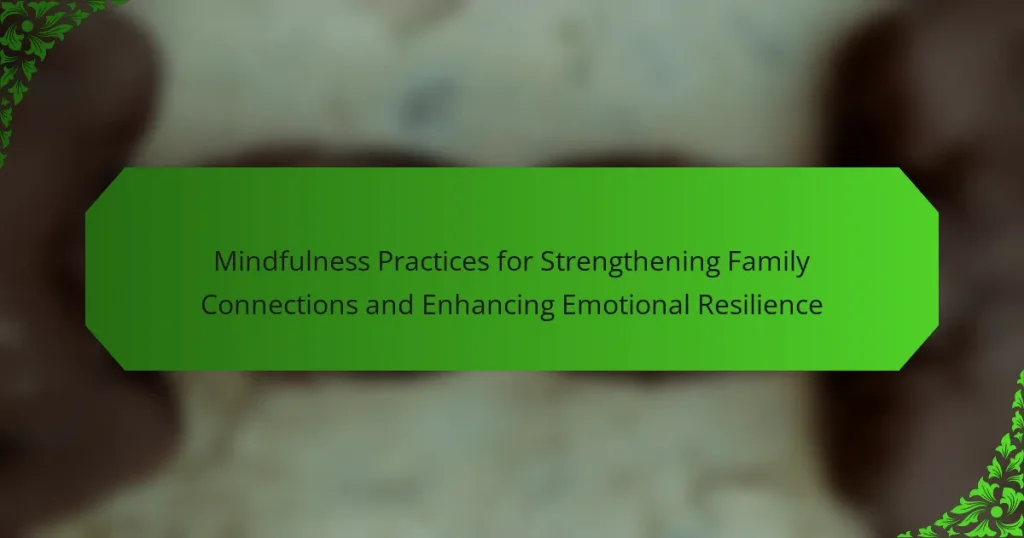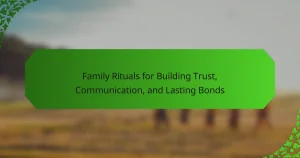Mindfulness practices can significantly enhance family connections and emotional resilience. Key techniques include active listening to improve communication, shared meditation for unity, and gratitude exercises to foster a supportive atmosphere. Additionally, incorporating culturally relevant elements and avoiding common pitfalls can maximize the effectiveness of these practices. Engaging in mindfulness together helps families navigate challenges with greater emotional strength.
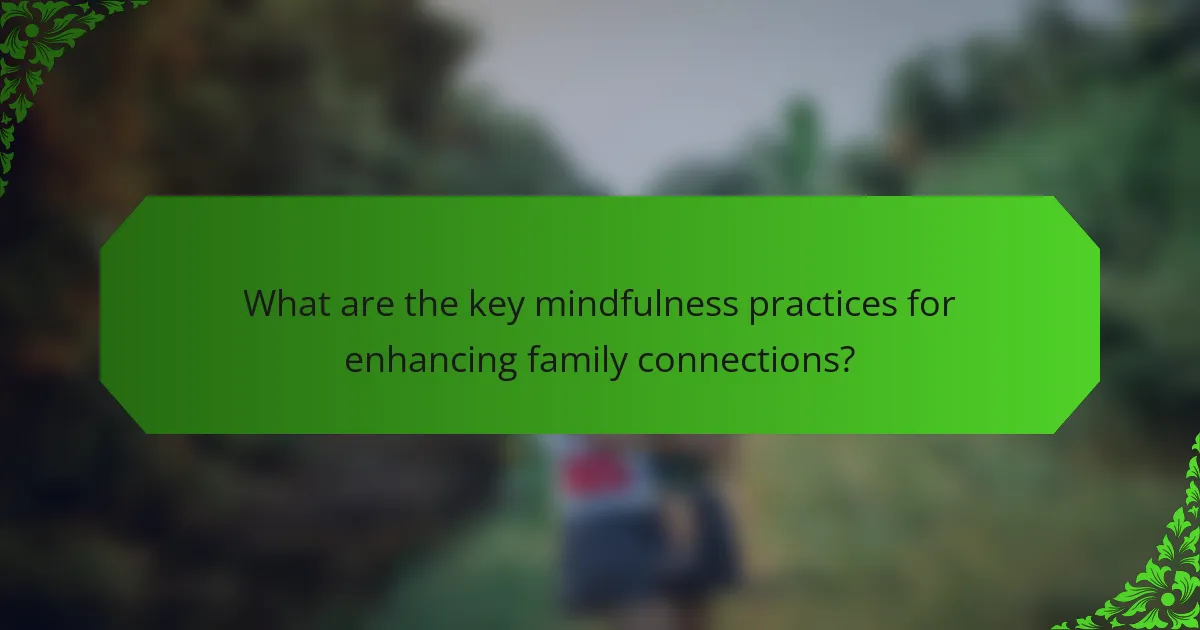
What are the key mindfulness practices for enhancing family connections?
Mindfulness practices that enhance family connections include active listening, shared meditation, and gratitude exercises. These practices foster emotional resilience and strengthen bonds among family members.
Active listening encourages open communication, allowing family members to feel heard and valued. This practice can significantly improve emotional understanding and reduce conflicts.
Shared meditation sessions promote a sense of unity and calmness. Engaging in mindfulness together helps families develop a collective emotional resilience, making them better equipped to handle stress.
Gratitude exercises, such as sharing daily appreciations, cultivate a positive family atmosphere. This practice enhances emotional connections and encourages a culture of support and recognition within the family.
How does mindfulness improve emotional resilience in families?
Mindfulness enhances emotional resilience in families by fostering open communication and reducing stress. Regular mindfulness practices help family members develop empathy and patience, creating a supportive environment. As a result, families can navigate challenges more effectively, strengthening their bonds. Studies show that families practicing mindfulness experience improved emotional awareness and conflict resolution skills, contributing to overall well-being.
What role does communication play in mindfulness practices?
Effective communication is vital in mindfulness practices as it fosters understanding and emotional connection within families. By openly sharing thoughts and feelings, family members enhance their emotional resilience. This practice encourages active listening, which builds trust and strengthens relationships. Mindfulness meditation can also improve communication skills, allowing individuals to express themselves clearly and empathetically. As a result, families that engage in mindfulness together often experience deeper connections and improved emotional well-being.
What techniques can families use to communicate mindfully?
Families can communicate mindfully by practicing active listening, expressing gratitude, and engaging in regular family meetings. These techniques foster emotional resilience and strengthen connections. Active listening involves fully concentrating on the speaker, validating their feelings, and responding thoughtfully. Expressing gratitude enhances positivity and reinforces emotional bonds. Regular family meetings create a safe space for open dialogue, ensuring everyone’s voice is heard and valued.
How can active listening enhance family relationships?
Active listening significantly enhances family relationships by fostering understanding and emotional connection. It encourages open communication, allowing family members to express feelings and concerns without judgment. This practice builds trust and empathy, which are essential for emotional resilience. As families engage in active listening, they create a supportive environment that nurtures healthy interactions and conflict resolution. Studies show that families practicing active listening experience improved relationships and reduced misunderstandings, leading to stronger bonds and greater emotional well-being.
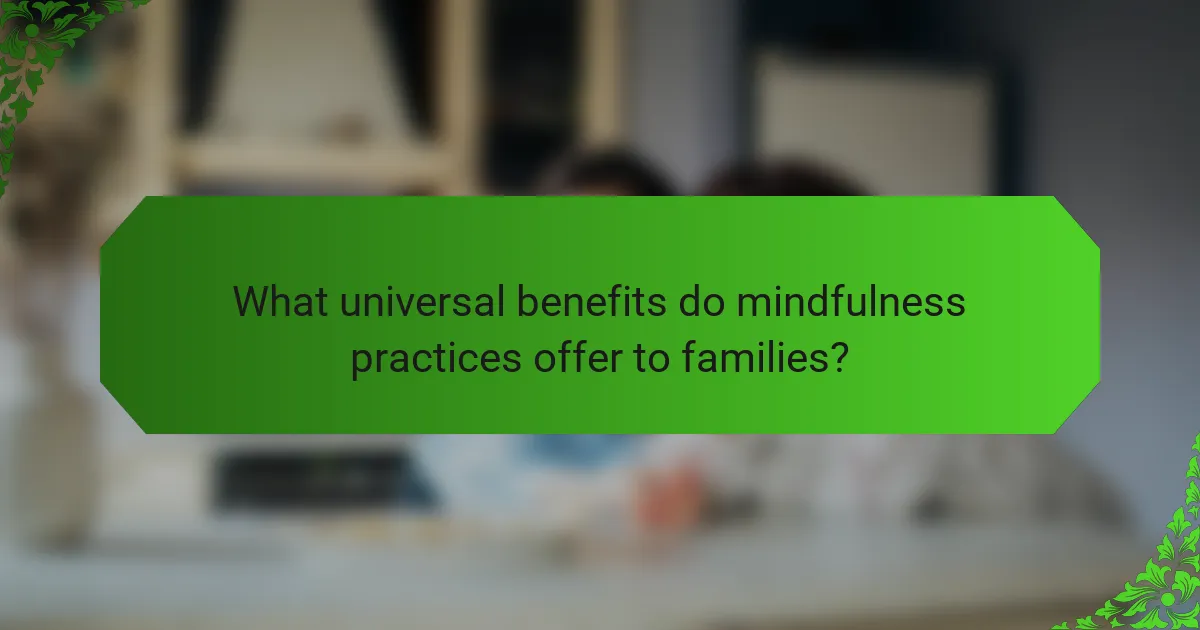
What universal benefits do mindfulness practices offer to families?
Mindfulness practices offer families enhanced emotional resilience, improved communication, and strengthened connections. These benefits foster a supportive environment where family members can express emotions and manage stress effectively. Engaging in mindfulness together promotes shared experiences, leading to deeper bonds and mutual understanding. Research indicates that families practicing mindfulness report lower levels of anxiety and greater overall well-being, highlighting the universal advantages of these practices.
How can mindfulness reduce family stress?
Mindfulness significantly reduces family stress by fostering emotional resilience and enhancing connections. Regular mindfulness practices, such as meditation and deep breathing, help family members manage their emotions, leading to improved communication and conflict resolution. Research indicates that families who engage in mindfulness together report lower stress levels and stronger bonds. These practices create a supportive environment, allowing individuals to express their feelings and needs more openly. As a result, families experience increased harmony and reduced tension, promoting overall well-being.
What impact does mindfulness have on family dynamics?
Mindfulness significantly enhances family dynamics by fostering emotional resilience and improving communication. It encourages active listening, empathy, and understanding among family members. Research shows that practicing mindfulness together can reduce stress and conflict, leading to stronger bonds. Families that engage in mindfulness report higher levels of satisfaction and emotional support.
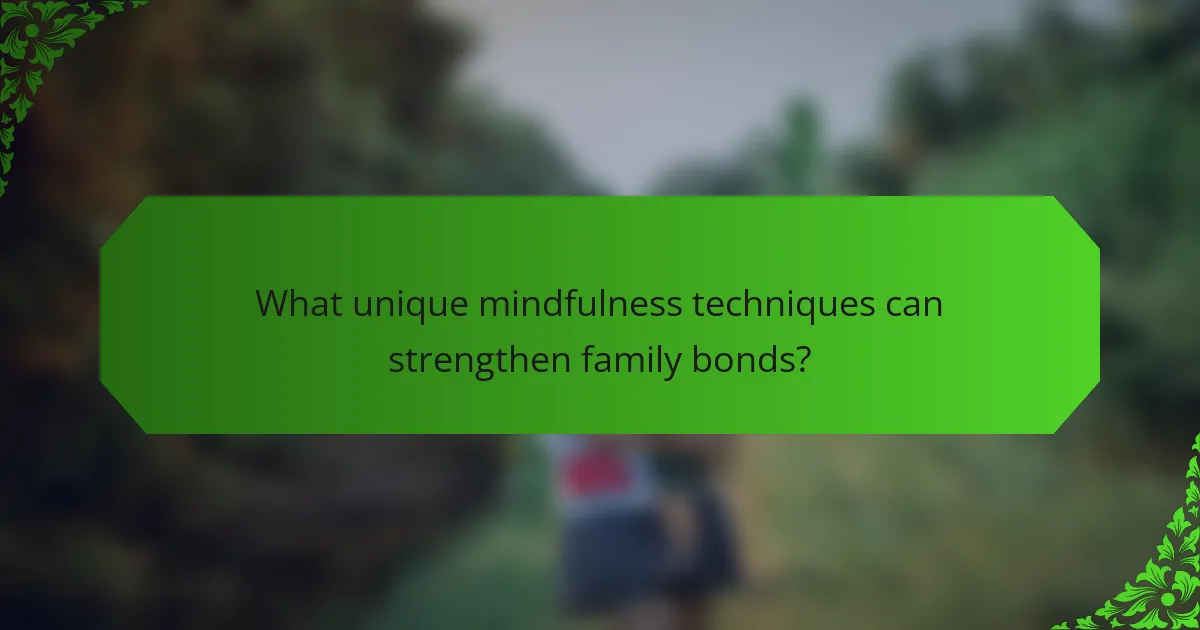
What unique mindfulness techniques can strengthen family bonds?
Mindfulness techniques can significantly strengthen family bonds by fostering connection and emotional resilience. Practices such as family meditation sessions, mindful communication exercises, and gratitude sharing can enhance awareness and empathy among family members. For instance, dedicating time each week for group meditation encourages collective calmness and unity. Additionally, engaging in mindful listening during family discussions promotes deeper understanding and reduces conflicts. These unique techniques create a supportive environment, allowing families to navigate challenges with greater emotional strength.
How can family rituals incorporate mindfulness practices?
Family rituals can effectively incorporate mindfulness practices by creating intentional moments for connection. Engaging in activities like shared meals, nature walks, or storytelling allows families to be present with one another. These practices enhance emotional resilience by fostering open communication and understanding. Regularly integrating mindfulness into family routines strengthens bonds and promotes a collective sense of well-being. For instance, dedicating time for gratitude reflections during family gatherings cultivates a positive atmosphere and nurtures emotional health.
What are the benefits of shared mindfulness activities?
Shared mindfulness activities enhance family connections and emotional resilience. They foster open communication, promote empathy, and reduce stress. Engaging in these practices together creates a supportive environment, strengthening bonds and improving overall mental well-being. Research indicates families practicing mindfulness report higher satisfaction and lower conflict levels.
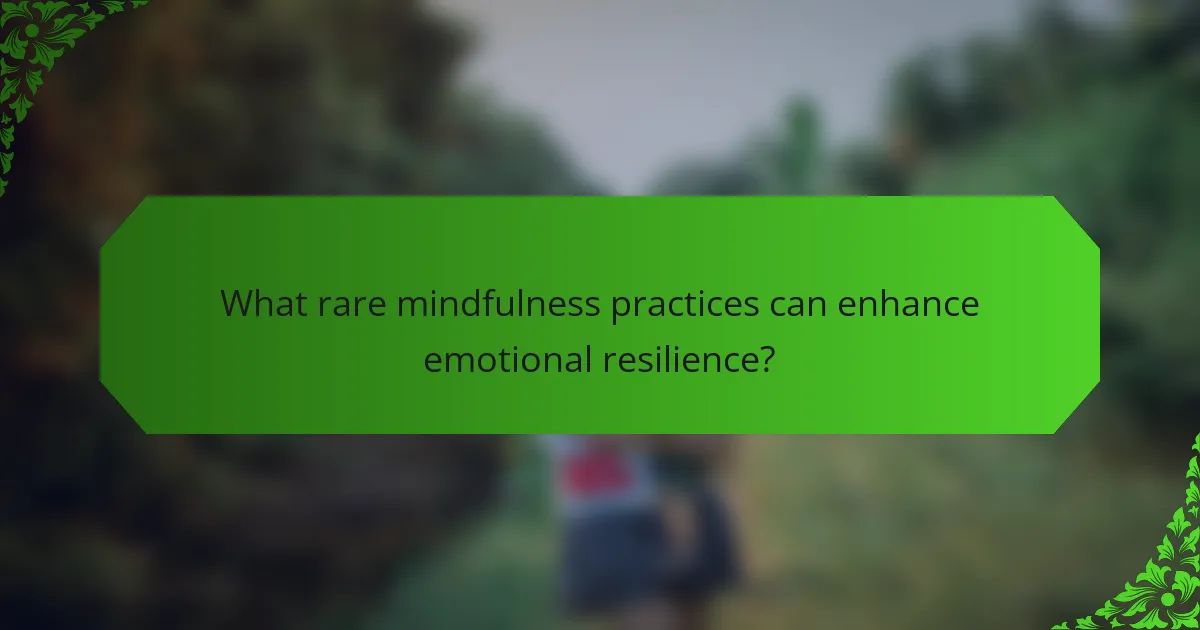
What rare mindfulness practices can enhance emotional resilience?
Practices such as forest bathing, expressive writing, and mindful art can enhance emotional resilience. Forest bathing involves immersing oneself in nature, which reduces stress and improves mood. Expressive writing allows individuals to process emotions, fostering healing. Mindful art encourages creative expression, promoting self-awareness and emotional clarity. Incorporating these rare practices can significantly strengthen family connections and individual resilience.
How can families practice gratitude mindfully?
Families can practice gratitude mindfully by engaging in regular, intentional activities that foster appreciation and connection. One effective approach is to create a gratitude jar where family members write down things they are thankful for and share them during family gatherings. This simple ritual enhances emotional resilience and strengthens family bonds.
Another method involves setting aside time for a gratitude circle, where each person expresses their gratitude for others, promoting positive communication. Research shows that such practices can improve overall family dynamics and emotional well-being.
Additionally, families can incorporate gratitude into daily routines, such as sharing three things they are grateful for at dinner. This consistent practice cultivates a mindset of appreciation and mindfulness, leading to deeper connections among family members.
What is the impact of nature on mindfulness and family connections?
Nature significantly enhances mindfulness and strengthens family connections by providing a calming environment that fosters emotional resilience. Engaging with nature encourages families to practice mindfulness together, promoting shared experiences that deepen relationships. Studies show that spending time outdoors reduces stress and anxiety, allowing family members to connect more authentically. Additionally, nature-based activities, such as hiking or gardening, create opportunities for meaningful conversations, further solidifying family bonds. Ultimately, integrating natural settings into family mindfulness practices cultivates a supportive atmosphere that nurtures emotional well-being.

How can families adapt mindfulness practices to different cultural contexts?
Families can adapt mindfulness practices by incorporating culturally relevant elements and traditions. This approach fosters emotional resilience and strengthens connections.
Cultural adaptations can include using local languages for mindfulness exercises, integrating traditional rituals, or aligning practices with communal values. For instance, a family might practice gratitude through storytelling, a common tradition in many cultures.
Additionally, families can explore mindfulness practices that resonate with their unique backgrounds, such as nature walks in culturally significant landscapes or meditation techniques rooted in their heritage. This personalization enhances the engagement and effectiveness of mindfulness.
Encouraging open discussions about cultural perspectives on mindfulness can also deepen understanding and connection among family members. By valuing each member’s cultural background, families can create a more inclusive and supportive environment.
What mindfulness practices are popular in various cultures?
Mindfulness practices vary across cultures, each enhancing family connections and emotional resilience. Popular methods include meditation from Buddhism, which promotes awareness and compassion; yoga from India, fostering physical and mental harmony; and family rituals in Indigenous cultures, strengthening bonds and shared values. Additionally, practices like gratitude journaling and nature walks are embraced globally, encouraging reflection and connection. These diverse approaches highlight the universal benefits of mindfulness in nurturing relationships and emotional well-being.
How can families in diverse backgrounds apply mindfulness effectively?
Families from diverse backgrounds can effectively apply mindfulness by embracing practices that foster connection and emotional resilience. Engaging in shared mindfulness activities, such as family meditation or mindful walks, enhances communication and understanding. Incorporating cultural elements into mindfulness practices can create a sense of belonging, allowing each family member to express their unique perspectives.
Regular family check-ins that include mindfulness techniques, like deep breathing or gratitude sharing, strengthen emotional bonds. These practices cultivate a supportive environment, promoting emotional well-being. Research indicates that families practicing mindfulness together experience improved relationships and reduced stress levels, highlighting the effectiveness of these approaches.
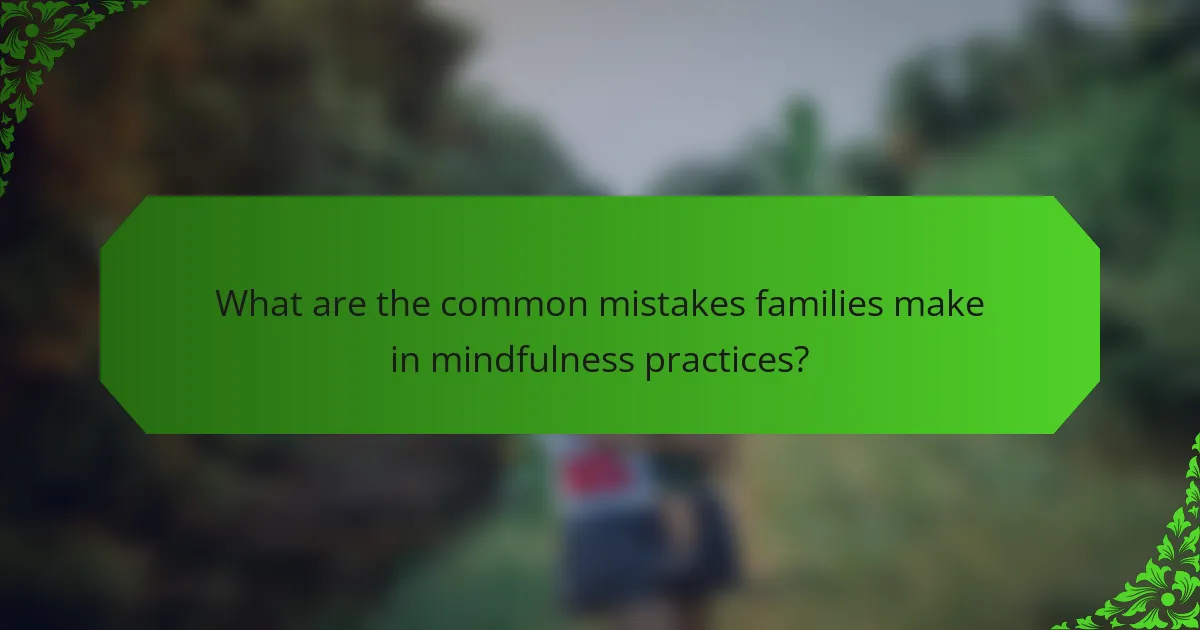
What are the common mistakes families make in mindfulness practices?
Families often overlook key aspects of mindfulness practices, leading to ineffective outcomes. Common mistakes include inconsistent practice, focusing solely on meditation without incorporating mindfulness into daily activities, and failing to communicate openly about feelings and experiences. Additionally, expecting immediate results can lead to frustration. Recognizing these pitfalls can enhance emotional resilience and strengthen family connections.
How can families avoid pitfalls in implementing mindfulness?
Families can avoid pitfalls in implementing mindfulness by establishing clear intentions, fostering open communication, and practicing regularly. Setting specific goals helps families stay focused on their mindfulness journey. Open discussions about experiences promote understanding and connection. Regular practice reinforces mindfulness habits, enhancing emotional resilience and family bonds.
What best practices should families follow for successful mindfulness integration?
Families should adopt consistent routines, create a supportive environment, and engage in shared mindfulness activities. Establishing a daily practice strengthens emotional resilience and connection. For example, family meditation sessions or mindful meals can enhance communication and understanding. Encouraging open discussions about feelings fosters a culture of emotional awareness. Regularly practicing gratitude as a family can further deepen bonds and promote positive mental health.
What are the steps for creating a family mindfulness plan?
Creating a family mindfulness plan involves several key steps.
1. Assess current family dynamics and emotional needs.
2. Set clear mindfulness goals tailored to family members.
3. Choose mindfulness practices suitable for all ages.
4. Schedule regular mindfulness sessions to foster consistency.
5. Encourage open communication about experiences and feelings.
6. Review and adjust the plan periodically based on feedback.
How can families track their mindfulness progress together?
Families can track their mindfulness progress together by setting specific goals and regularly discussing experiences. Engaging in shared mindfulness activities, such as meditation or yoga, creates a collective journey. Use journals to document individual reflections and insights, fostering open communication. Establish a routine for family check-ins to celebrate milestones and address challenges. This collaborative approach enhances emotional resilience and strengthens family connections.
What expert insights can enhance family mindfulness practices?
To enhance family mindfulness practices, focus on intentional communication and shared activities. Engaging in regular family discussions about feelings fosters emotional resilience. Incorporating mindfulness exercises, such as breathing techniques, can strengthen connections. Establishing a routine for mindfulness activities promotes consistency and deeper engagement.
